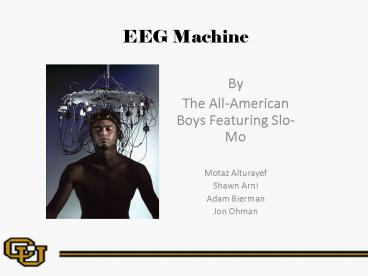EEG Machine - PowerPoint PPT Presentation
1 / 25
Title:
EEG Machine
Description:
EEG Machine By The All-American Boys Featuring Slo-Mo Motaz Alturayef Shawn Arni Adam Bierman Jon Ohman Project Goals Goals: Design an EEG (Electroencephalography ... – PowerPoint PPT presentation
Number of Views:661
Avg rating:5.0/5.0
Title: EEG Machine
1
EEG Machine
By The All-American Boys Featuring Slo-Mo Motaz
Alturayef Shawn Arni Adam Bierman Jon Ohman
2
Project Goals
- Goals
- Design an EEG (Electroencephalography) machine
to promote the generation of user selected
brainwave frequencies - Accesible Frequency ranges (Theta, Alpha, Beta)
- Using Audio and Video Feedback to synchronize
brain
3
Block Diagram Description
4
Physiology and Input Design
5
Physiology of Neurofeedback
- Brain waves divided into distinct frequency
bands - Delta 0-3 Hz, Associated with slow wave sleep
- Theta 4-7 Hz, Associated with drowsiness or
arousal - Alpha 8-13 Hz, Associated with relaxed
concentration or contentment - Beta 14-30 Hz, Associated with intense
concentration, high levels of thought activity
6
Physiology Continued
- Synchronization of Brain waves is possible
- External stimuli used to synchronize brain wave
frequencies - Our project will use both audio and video stimuli
to synchronize waves - Can be used to train an individual to put
themselves in desired state
7
Electrode Input Design
- Five electrode two channel EEG headband for
signal monitoring - Design compiled from multiple schematics
- Using active electrodes
- Powered either with lithium batteries or hard
line to main board - Small voltage values require ultra low noise
devices
8
Amplification, Filtering, and A/D
- Done at main board
- Amplifier strengthens microvolt signals to usable
levels - Signal passes through low-pass and high pass
filters to remove DC components and higher
frequency noise and brain waves - Possibly sent through band-pass filters as well
- Digitized using low noise A/D converter
9
Design Aspects
- Low signal levels require very low noise devices
- Battery powering could introduce too much signal
noise unless properly shielded - Two channels sufficient to measure frequency
content - Differential voltage measurements
- Fifth electrode along scalp midline to create
unbiased ground
10
Risks
- Too much noise in system
- Will distort signal and render it useless
- Can use commercial electrodes, conductive paste
- Filters should assist in removing noise, also use
shielding techniques for battery and twisted
pairs for wires - Two channels insufficient for measurement
- Possible to build more channels
- Filters drop off too shallowly to isolate bands
- Only a problem if band-pass filtering is employed
(Additional Feature)
11
Flash Memory and System Outputs
12
Physiological Effects of Outputs
- Alter brain frequency through external stimulus
- Auditory stimulus is most effective
- Produce a stimulating frequency equal to that of
the desired brain frequency state - Binaural beats Auditory processing artifacts,
the perception of which arises in the brain
independent of physical stimuli - Visual stimulus is another common option
- A screen or monitor flashes an image at the rate
of the desired brain frequency state
13
Memory Options
- Two types
- RAM (Volitile)
- ROM (Non-Volitile)
- SD Card Flash
- Easy to load
- Board Mounted Flash
- More permanent
14
Spansion Memory
- 8 MBIT Storage
- 3.0V Supply
- No Bus Contention
- Memory controller in Altera FPGA
- Controller allows access to program and read data
from memory - Controller will also transfer data to audio/video
controller for output
15
Output Flow
16
Risks
- Not enough room in Flash for both audio and video
signals - Can revert to SD Card where more space is
available - High risk of epileptic seizures with a flashing
monitor - Warning must be presented
- Auditory signal can be used exclusively
17
- PC (Matlab or LabView)
- Analyze the brainwave for frequency content and
find the dominant frequency. - Two Approaches of doing this
- Signal as a whole and do Power Spectral Density
(PSD) analysis. - Divide the signal into 4 frequency bands then do
PSD. - Risks
- Not being able to debug the code with real
brainwave signals. - Synchronising the PC output with the whole
system.
18
Processor Flow Diagram
19
Altera DE2 Development Board
- I/O needs
- Readily available
- 32-bit Nios II embedded processor SOPC Builder
configuration integration - Quartus II - Scalable environment
20
DE2 Risks
- Risks
- Too much reliance on built-in features
- Input data usable? (ADC conversion)
- Potential usage of development boards many
options may spread team too thin - Alternate choice MSP430
21
Processor Testing
- Input Signals
- User Input on LEDs
- Verify Electrode/ADC sample and store, as audio
output - Check DF result and store using 7-segment
displays/LEDs - Show difference between UI and DF on LED/7
segment
22
Processor Testing
- Output Signal
- Stored Electrode/ADC signal to PC, output as
audio on PC - Wait State
- Between samples illuminate LED
23
Budget
24
Schedule
- See Microsoft Project
25
Questions?































